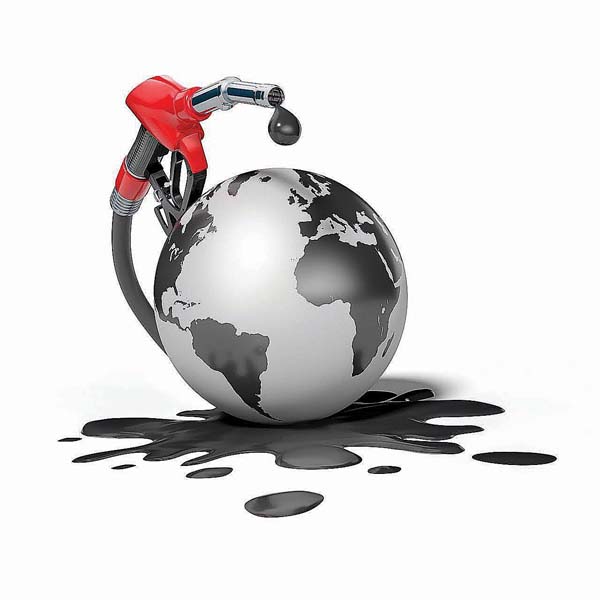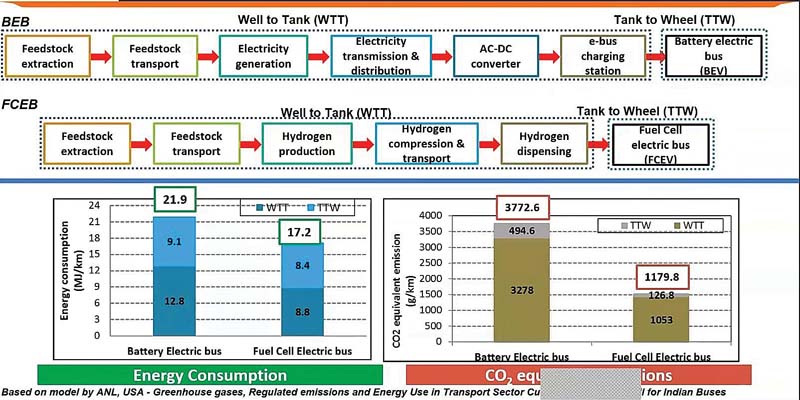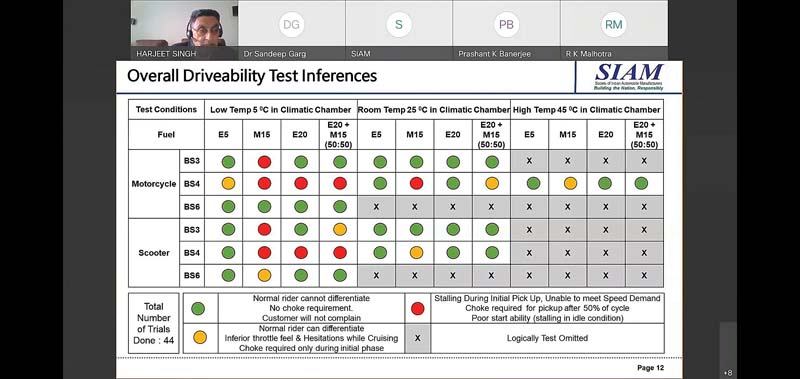The 17th lecture of the Siam environment Series focused on the role of fuels in attaining SDGs. Deepti thore picks the fuel-agnostic ways deliberated upon.
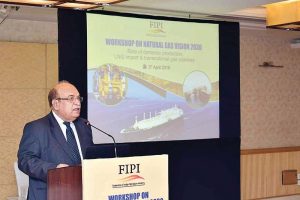
Society of Indian Automobile Manufacturers (SIAM) hosted the 17th lecture of its ‘Environment Series’. Focused on the theme ‘Sustainable Road map for Fuels in the Automotive sector’, it drew attention to adopt a fuel-agnostic approach for the automotive industry to mitigate climate change and attain its Sustainable Development Goals (SDGs). The session had speakers deliberating on an array of linked subjects like energy security, national priority and pollution mitigation of cities driven by a comprehensive and considerate approach of Government of India (GoI). With the latter defining a multi-fuel option road map, the surface transport sector (road transport in particular) has its task cut out. It involves de carbonisation in a very systematic manner involving goal posts over a near, mid- to long-term basis.. “Meeting the sustainable fuel road map will be a challenge for both, the automotive and Oil Marketing Companies (OMCs),” commented Dr R K Malhotra, Director General of the Federation of Indian Petroleum Industry (FIPI) as he opened the floor for and against the school of thought.

Technologies and Sustainability,
Mobility Division, TÜV SÜD
Echoing a similar sentiment, and highlighting the need for de carbonisation of road transport, Pascal Mast, Director – New Technologies and Sustainability, Mobility Division, TÜV SÜD, drew attention to the increasing number of natural disasters raising a red flag against the wanting climate change mitigation measures. His views call for strengthening the global response on global warming. Talking about de carbonisation, Malhotra opined, “Even though Electric Vehicles (EVs) are expected to reduce carbon emissions from the tailpipe, the pilferage at source is a question mark.” Admitting to the use of renewable energy for generation of electricity in isolation, the cradle-to-cradle approach is yet to be established in the auxiliaries like battery packs which allegedly end up in the landfills. “The need is for a life cycle analysis,” he reiterated. Stressing on making EVs affordable to make it a mass-mobility option in India, Dr SSV Ramakumar – Director (R&D) and Board Member, Indian Oil Corporation Ltd. presented a case study wherein he analysed the downward trend in India’s carbon emissions especially from the peaks of 2018 -19 (refer to the adjoining graph). Predicting the trend to sustain itself in the aftermath of the lockdown, he circled back to the importance of keeping a fuel-agnostic stance for the road ahead.
Resource allocation for alternative fuels
Fuel-agnostic approach is reliant on alternative fuels. According to Som Kapoor, Partner and Principal, Ernst & Young, the focus on reducing the fiscal deficit by way of reduction of the import bill, the role of non fossil-fuels were highlighted. “We import a lot of our oil. India’s annual crude import bill is ~Rs.12 lakh crore,” he cited. Adding that the import prices of fuel have been volatile and changed drastically over the past year (2020-21), it is a far cry from a sustainable approach, he quipped. The current fuel roadmap is outdated and 50-70 years old, crying for a change, , he asserted. Talking about decline in carbon emissions, Som was quick to refer to an annual study taking into account carbon emissions from buses used for passenger transport. The figure, he claimed, stood at an estimated 40 million tonnes. More than 90 million tonnes was attributed to road freight transport. 30 Indian cities out of 100 are most polluted cities in the world with Delhi vehicular emission contributing ~59 per cent of the whole.
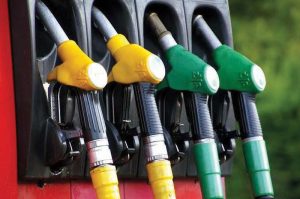 Adding his views to the import viability of fuels, Dr Anjan Ray, Director, Indian Institute of Petroleum stated, “We import, primarily petroleum, coal and natural gas, in various forms.” Appealing to the SIAM members among other stakeholders, Dr Ray drew attention to the underlying opportunity in promoting alternative fuels. On the one crop focus across a majority of the acreage in the country, he called for the need to consider diversion of a 40 million acre land parcel for production of biofuels.
Adding his views to the import viability of fuels, Dr Anjan Ray, Director, Indian Institute of Petroleum stated, “We import, primarily petroleum, coal and natural gas, in various forms.” Appealing to the SIAM members among other stakeholders, Dr Ray drew attention to the underlying opportunity in promoting alternative fuels. On the one crop focus across a majority of the acreage in the country, he called for the need to consider diversion of a 40 million acre land parcel for production of biofuels.
Citing the change of discourse from alternate and renewable fuels to a net zero commitment, expressed Dr Ray, “The first shift of this discourse would be to make supply chains sustainable.”,he mentioned. Laying stress on choosing application specific fuels, his views were echoed by Krishnan Sadagopan, Senior Vice President- Engine development, Ashok Leyland calling for a joint R&D initiative with the OMCs.
Policy interventions
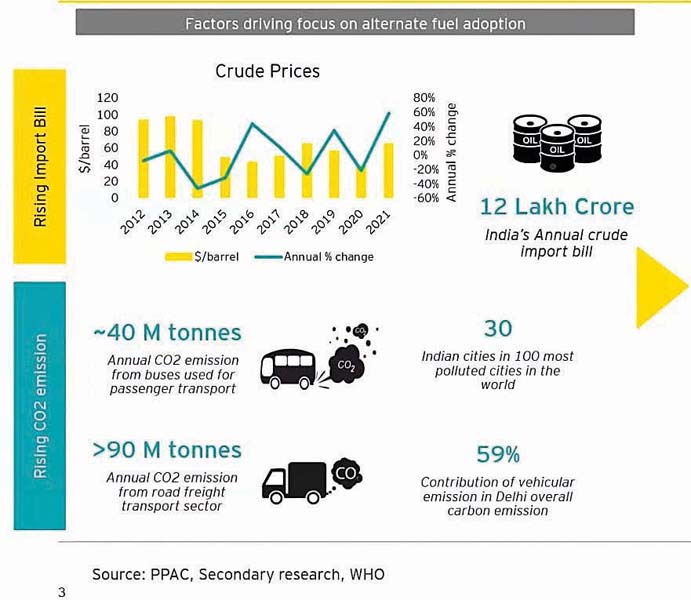 GoI was lauded for interventions to curtail excessive importance and focus on net zero emissions as per Som Kapoor. At the same time he expressed concern over few policies that were in effect in the real-world. He referred to the ‘National Policy on Biofuels’, ‘Draft Policy of City Gas Distribution (CGD)’, ‘Draft LNG Policy’, ‘Fame-II policy for promoting use of EVs and building the ecosystem besides the ‘Draft National Hydrogen Energy’ mission to promote hydrogen vehicles. “Our ministry is continuously working to reduce import of fossil fuels and focusing on local renewable energy sources in the entire energy mix of India,” mentioned Sunil Kumar, Joint Secretary (Refineries), Ministry of Petroleum & Natural Gas, New Delhi. He also highlighted, “Our refineries have spent around Rs.30,000 crore to remove sulphur content from the petrol and keep it at 10 ppm.” Commending the industry for successful migration from BSIV to BSVI, he said that the industry is focusing on novel fuels and by 2025-26 petrol will have 20 per cent blended ethanol.
GoI was lauded for interventions to curtail excessive importance and focus on net zero emissions as per Som Kapoor. At the same time he expressed concern over few policies that were in effect in the real-world. He referred to the ‘National Policy on Biofuels’, ‘Draft Policy of City Gas Distribution (CGD)’, ‘Draft LNG Policy’, ‘Fame-II policy for promoting use of EVs and building the ecosystem besides the ‘Draft National Hydrogen Energy’ mission to promote hydrogen vehicles. “Our ministry is continuously working to reduce import of fossil fuels and focusing on local renewable energy sources in the entire energy mix of India,” mentioned Sunil Kumar, Joint Secretary (Refineries), Ministry of Petroleum & Natural Gas, New Delhi. He also highlighted, “Our refineries have spent around Rs.30,000 crore to remove sulphur content from the petrol and keep it at 10 ppm.” Commending the industry for successful migration from BSIV to BSVI, he said that the industry is focusing on novel fuels and by 2025-26 petrol will have 20 per cent blended ethanol.
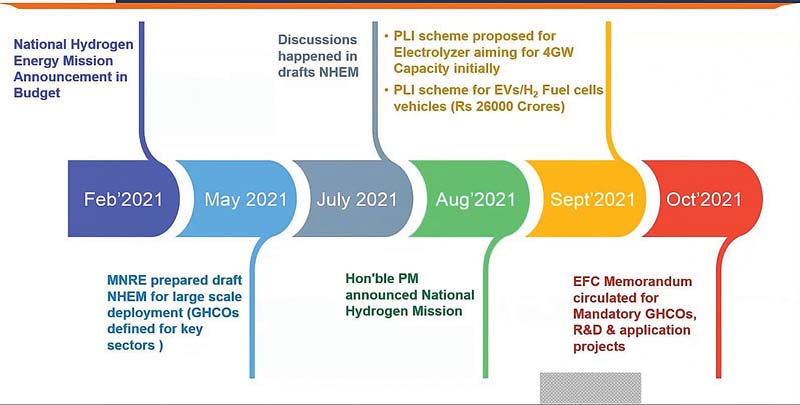 As highlighted by Kumar, the ministry has already piloted a recent hydrogen blended CNG experiment conducted in Delhi where 18 per cent hydrogen was blended in CNG by volume. It is claimed to have given significant benefits. With a bulk of transportation fuel consisting of BSIV compliant processes and CNG, this is a promising development. Talking about India’s commitment at the COP26, Ramakumar promoted the use of Hydrogen as the alternative fuel. He drew attention to the five prong strategy, also known as ‘Panchamrit’, the Indian declaration at COP26 that focuses on raising non-fossil fuel based energy capacity to 500 GW by 2030; meeting the target of 50 per cent of country’s energy requirements using renewable energy by 2030; reducing total projected carbon emission by one billion tonnes up to 2030; reducing carbon intensity of economy to less than 45 per cent by 2030 and India to become carbon neutral and achieve net zero emission by 2070.
As highlighted by Kumar, the ministry has already piloted a recent hydrogen blended CNG experiment conducted in Delhi where 18 per cent hydrogen was blended in CNG by volume. It is claimed to have given significant benefits. With a bulk of transportation fuel consisting of BSIV compliant processes and CNG, this is a promising development. Talking about India’s commitment at the COP26, Ramakumar promoted the use of Hydrogen as the alternative fuel. He drew attention to the five prong strategy, also known as ‘Panchamrit’, the Indian declaration at COP26 that focuses on raising non-fossil fuel based energy capacity to 500 GW by 2030; meeting the target of 50 per cent of country’s energy requirements using renewable energy by 2030; reducing total projected carbon emission by one billion tonnes up to 2030; reducing carbon intensity of economy to less than 45 per cent by 2030 and India to become carbon neutral and achieve net zero emission by 2070.
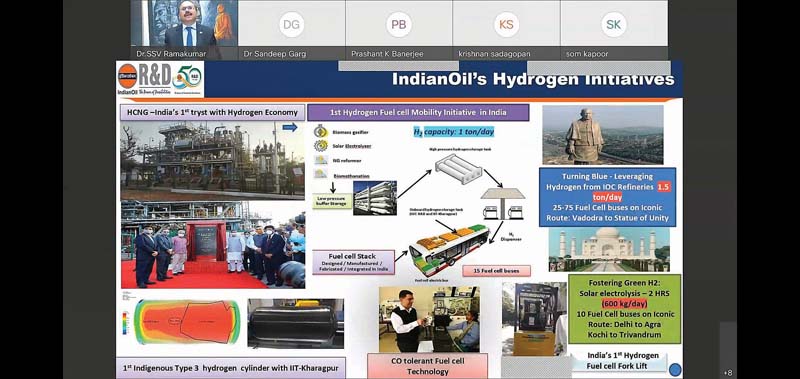 Ramakumar drew attention to some of the key initiatives driven by IOCL to promote hydrogen as an alternative fuel. He mentioned that they will be running 15 FCEBs supplied by Tata Motors in the Delhi NCR region. These buses will be introduced in phase wise manner over the span of next three years starting from 2022. They are the first to carry out Hydrogen fuel cell mobility initiative in India, claimed Ramakumar. They have developed the first indigenous type 3 hydrogen cylinder with IIT Kharagpur and CO tolerant fuel cell technology. They also produced HCNG, India’s first tryst towards hydrogen economy.
Ramakumar drew attention to some of the key initiatives driven by IOCL to promote hydrogen as an alternative fuel. He mentioned that they will be running 15 FCEBs supplied by Tata Motors in the Delhi NCR region. These buses will be introduced in phase wise manner over the span of next three years starting from 2022. They are the first to carry out Hydrogen fuel cell mobility initiative in India, claimed Ramakumar. They have developed the first indigenous type 3 hydrogen cylinder with IIT Kharagpur and CO tolerant fuel cell technology. They also produced HCNG, India’s first tryst towards hydrogen economy.

On the Ethanol blending roadmap, Ramaprabhu R – Principal Engineer-Head, Fluids Technology- Mahindra & Mahindra mentioned that after the Ethanol Blending Motor Gasoline (EBMG) in 2008, the increased focus was made on the fuel since 2015 and built upon by the National Biofuel policy announced in 2018. It played a role in boosting the Ethanol Blending Roadmap in 2021. The ethanol production boost at the domestic level, both from sugar and other food grains, to meet the E10 and E20 targets looks promising, he opined.
Infrastructure status and roadmap
According to Som Kapoor, the natural gas infrastructure strategy is projected to help increase in terms of gas transmission pipeline length (km) from 16,200 km in FY20 to 27,430 in FY25. It is also projected to help increase CNG stations across the country from 2543 in FY20 to 10,000 in FY26. The policy is also projected to help increase LNG stations across the country from 50 in phase 1 to 1000 in phase 2. The policy focused on increase in biofuel production capacity is expected to help boost ethanol supply and the one focused on EV charging stations will help commission highways with EV charging infrastructure. There are two hydrogen refuelling stations which are currently established at the Indian Oil R&D centre. A financial outlay of USD 106 million has been proposed from 2021-24.

Mentioning that the ministry of Petroleum and Natural Gas is working towards wider acceptance of CNG fuel expanding from existing 2300 stations to over 10,000 stations by 2025, Kumar opined,”The future of Indian mobility will be decided by penetration of large numbers of gas vehicles. I believe that this decade we’ll see the emergence of many novel fuels which will help us progress in a sustainable manner on the fuel road map”. While speaking about demand and supply of natural gas in India, Praveen Kumar Pandey, Senior Vice President- Indraprastha Gas Ltd., mentioned that India imports LNG and it’s percentage share has increased to ~ 60 per cent FY21. He also spoke of the impetus on infrastructure boost to in turn propel gas demand and consumption. There are 10 LNG terminals which are under development with the pipeline network being extended by 13000 kms. He hailed the incentives in place for exploring and extracting gas. LNG has been approved as fuel for highways with approximately 200 LNG stations proposed in the next three years and city gas distribution expanded from 78 to 400 districts with another 250 being tendered. LNG is being looked at as a fuel for long haul transport including the buses.
Alternative fuel roadmap
Availability of multiple alternate fuel technologies will lead to adoption of fuel type based on specific application, opined Som Kapoor. Electric, biofuel, and natural gas, for example, have a varying impact on operational capacity, performance, cost and emissions. According to Kapoor, by 2030, multiple alternate fuel technologies will be available for each vehicle segment thereby making selection of fuel based on operational and commercial feasibility.
Ray drew attention to fuel production by recycling plastics. While pointing at the plastic-to-fuel project in Pune which derives fuel from plastic generated in the city, Ray insisted on considering biodiesel and green diesel as alternate fuels. The need is to look at CSR disruptive areas such as EV retrofits.and decentralised biodiesel.
Promoting the use of LNG as alternative fuel,s Kumar requested commercial vehicles manufacturers to adopt LNG as important fuel, especially for long haul trucks as it is done in Europe. According to the Hydrogen Council Vision shared by Ramakumar, there would be 400 million cars, 15-20 million trucks and five million buses by 2050 for which 330 MTPA hydrogen is needed. He also presented a comparison wherein Fuel Cell Electric Buses(FCEBs) made a net positive impact compared to Battery Electric Buses(BEBs).
Highlighting the advantages of LNG as an alternative fuel, Pandey mentioned, LNG offers ease and safety of non-pressurised storage or transport. LNG achieves higher reduction in volume than CNG. The volumetric density of LNG is 2.4 times greater thank that of CNG (at 259 bar). He added that organic waste can be purified to get automotive fuel grade methane which when compressed can work as Bio-CNG.
Promoting flex-fuel
According to Ramaprabhu,the need is for defining fuel quality and specifications by BIS. The test agencies need to amend the proposed regulations and safety standards, and customer acceptability. It was said, multiple inter-dependencies on customer, automotive manufacturers, fuel suppliers and government further complicate the alternate fuel adoption road map of India. According to Kapoor, the customer will remain the same but the application will change quite drastically. Both the speed and the quantum of change in the next five years will be more than what the speed of change has been in the last 50 years.
Global alternative fuel road map
As per the study shared by Kapoor, economies across the globe have adopted a fuel based approach or emission reduction based approach for designing the alternate fuel road map. Countries like Brazil, for example, started ethanol blending in the 1930s and mandated 27 per cent ethanol blending in 2017. Japan developed its first hydrogen fuel cell car in 2014 and is more focused on hydrogen as the future of automotive fuel. California focused on regional adoption and incentives for pilots. Canada is more focussed on regulating and incentivising the end users. Mast elaborated on the fuel cell to ICE usage globally. He pointed at the EU Green Deal initiative aimed at reducing 90 per cent transport related GHG emissions by 2050 compared to 1990 levels. There are other world wide credit programs and legal sales quote to promote Zero and Low Emission Vehicles (ZLEV) that need to be bench marked, he concluded.
Also read, Mobility Trends in CVs




